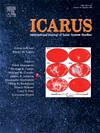Modelling the effect of volcanic outgassing of sulphur on early Martian surface temperatures using a 3-D Global Climate Model
IF 2.5
2区 物理与天体物理
Q2 ASTRONOMY & ASTROPHYSICS
引用次数: 0
Abstract
Around the time of the transition from the Late Noachian to the Early Hesperian eras (3.6 Gya), Mars was predicted to have been both volcanically active, and have sustained a climate warm enough to melt liquid water on its surface episodically despite a faint young sun. The effect of volcanic outgassing on the climate of early Mars and its ability to raise temperatures above the melting point of water has, however, been disputed, with a major uncertainty being the timescales over which the greenhouse effect of outgassed sulphur dioxide (SO2) and hydrogen sulphide (H2S) can warm the atmosphere of Mars before they react to form H2SO4 and S8 aerosols which act to cool the surface of Mars. We have developed the first 3-D model of the Martian sulphur cycle from source to sink that includes outgassing of SO2, H2S and S2 from the surface, the formation of H2SO4 and S8 through atmospheric chemistry, and the condensation and deposition of H2SO4 and S8 to the surface. We simulate the effect of a single large, day-long volcanic outgassing event on global surface temperatures, identifying the magnitude and duration of any net warming and cooling as a function of outgassing magnitude, atmospheric pressure, obliquity and aerosol particle size distribution. We confirm the results of Tian et al. (2010, EPSL 295, 412-418) and find that the persistence of the warming effect of volcanically outgassed SO2 and H2S on the Martian atmosphere is only of the order of days to weeks for a surface pressure range of between 0.5 and 1.5 bars. Typical outgassing magnitudes result in a net cooling of the Martian surface over timescales of 3–4 years near the equator and several decades at the poles for plume neutral buoyancy heights within the troposphere. For very high magnitudes of outgassing, the rate of H2SO4 cloud formation slows down due to the depletion of water vapour in the atmosphere, thereby slowing down the rate of cooling and providing a buffer against atmospheric collapse.
利用三维全球气候模型模拟火山喷发硫气体对早期火星表面温度的影响
据预测,在挪亚纪晚期到希斯纪早期的过渡时期(~ 3.6 Gya),火星既火山活跃,又维持了足够温暖的气候,使其表面的液态水在微弱的年轻太阳下偶尔融化。然而,火山释放气体对早期火星气候的影响及其将温度提高到水的熔点以上的能力一直存在争议,主要的不确定性在于,释放的二氧化硫(SO2)和硫化氢(H2S)的温室效应在它们反应形成H2SO4和S8气溶胶(用于冷却火星表面)之前可以使火星大气变暖的时间尺度。我们已经开发了第一个火星硫循环的三维模型,从源头到汇,包括从表面放出SO2, H2S和S2,通过大气化学形成H2SO4和S8,以及H2SO4和S8在表面的凝结和沉积。我们模拟了一次大型的、持续一天的火山喷发事件对全球地表温度的影响,确定了任何净增温和净降温的幅度和持续时间,并将其作为喷发幅度、大气压力、倾角和气溶胶粒径分布的函数。我们证实了Tian et al. (2010, EPSL 295, 412-418)的结果,并发现火山释放的SO2和H2S对火星大气的增温效应持续时间只有几天到几周,地表压力范围在0.5到1.5巴之间。典型的放空强度导致火星表面在赤道附近3-4年的时间尺度上的净冷却,在对流层内的羽流中性浮力高度的两极几十年的时间尺度上的净冷却。对于非常大的放气量,由于大气中水蒸气的耗尽,H2SO4云的形成速度减慢,从而减缓了冷却的速度,并为大气崩溃提供了缓冲。
本文章由计算机程序翻译,如有差异,请以英文原文为准。
求助全文
约1分钟内获得全文
求助全文
来源期刊

Icarus
地学天文-天文与天体物理
CiteScore
6.30
自引率
18.80%
发文量
356
审稿时长
2-4 weeks
期刊介绍:
Icarus is devoted to the publication of original contributions in the field of Solar System studies. Manuscripts reporting the results of new research - observational, experimental, or theoretical - concerning the astronomy, geology, meteorology, physics, chemistry, biology, and other scientific aspects of our Solar System or extrasolar systems are welcome. The journal generally does not publish papers devoted exclusively to the Sun, the Earth, celestial mechanics, meteoritics, or astrophysics. Icarus does not publish papers that provide "improved" versions of Bode''s law, or other numerical relations, without a sound physical basis. Icarus does not publish meeting announcements or general notices. Reviews, historical papers, and manuscripts describing spacecraft instrumentation may be considered, but only with prior approval of the editor. An entire issue of the journal is occasionally devoted to a single subject, usually arising from a conference on the same topic. The language of publication is English. American or British usage is accepted, but not a mixture of these.
 求助内容:
求助内容: 应助结果提醒方式:
应助结果提醒方式:


